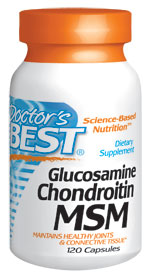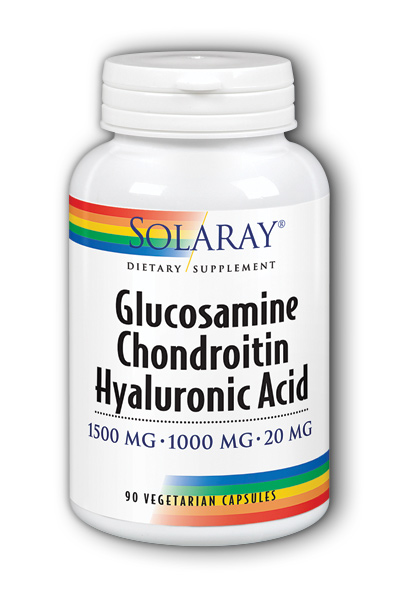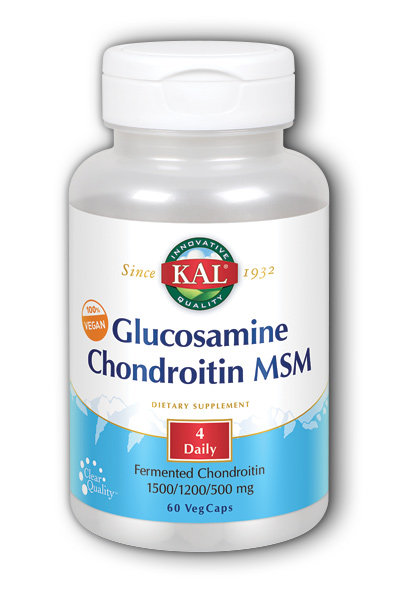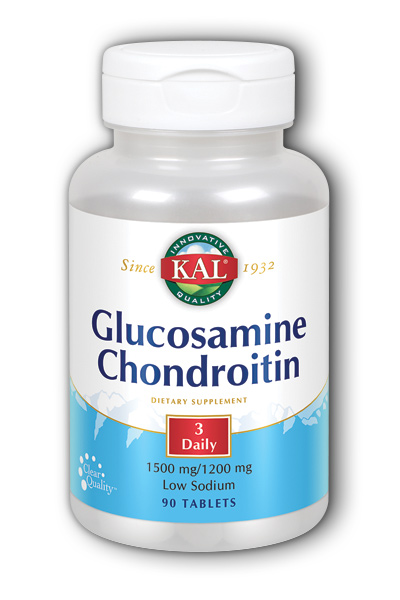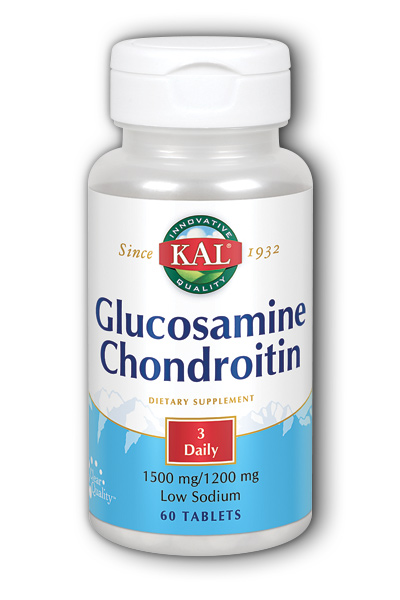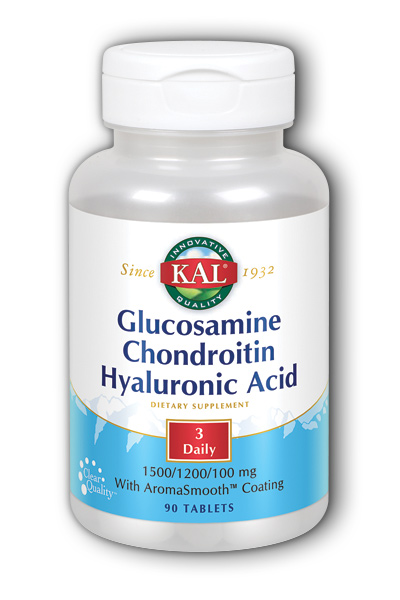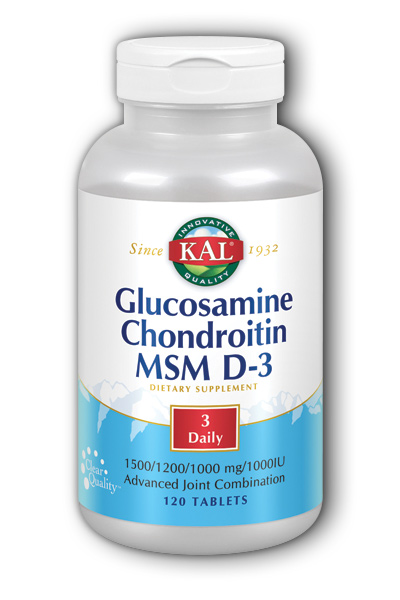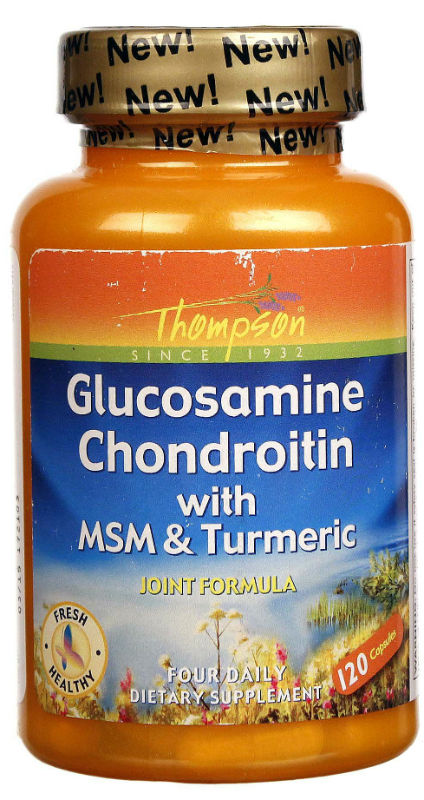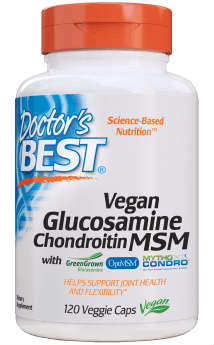- UPC: 753950000803
- # DRB-00080
Glucosamine / Chondroitin / MSMSupplement Facts:
Serving size 2 capsules Chloride (from glucosamine sulfate 2KCl).............84mg Sodium (from chondroitin sulfate sodium).............28mg potassium (from glucosamine sulfate 2KCl)............91mg Glucosamine sulfate 2KCl...........750mg
Chondroitin sulfate................600mg
Methylsulfonylmethane...............500mg other ingredients: gelatin capsule, cellulose, magnesium stearate (vegetable source). suggested use: as a dietary supplement, take 2 capsules twice daily, with or without food. Note: glucosamine is obtained from the shells of shellfish.
Best Glucosamine Sulfate contains pure glucosamine sulfate, as confirmed by HPLC testing. Glucosamine sulfate consists of glucosamine, an amino sugar extracted from "chitin," a component of shellfish skeletons. ("Chitin," the resilient polysaccharide that forms the structural framework of animal shells, is a long-chain polymer consisting of many glucosamine molecules linked together.) The purified glucosamine is then sulfated and stabilized with potassium chloride. Note: Glucosamine sulfate is derived from the shells of ocean-growing shellfish. It is processed to remove all residues of protein and impurities, yielding pure glucosamine sulfate as the final material. Glucosamine/Chondrotin/MSM contains chondroitin sulfate with a purity of 90 percent or greater. Quality assurance testing is performed using two sophisticated laboratory analysis methods: 1) HPLC and 2) C.P.C. Titration, a newly developed method now accepted as the most definitive test for chondroitin sulfate. Glucosamine/Chondrotin/MSM contains pure LIGNISUL MSM (methylsulfonylmethane). LIGNISUL™ MSM is natural-source MSM derived from trees. A biological compound that occurs in the human body and in some foods, MSM is an excellent dietary source of bioavailable organic sulfur. Understanding Glucosamine Sulfate and Chondroitin Sulfate and Their Roles in Joints Cartilage contains connective tissue composed of cells (chondrocytes), protein fibers (chiefly collagen) and clusters of complex molecules called "proteoglycans." Proteoglycan molecules are formed from long proteins (polypeptides) with numerous side chains. (The proteoglycan structure looks like a bottle brush.) The attached side chains, chiefly chondroitin sulfate and keratin sulfate, are long polysaccharide molecules called "glycosaminoglycans." 1,2 Glucosamine is a key component of keratin sulfate, and it can be converted to galactosamine, which, along with glucuronic acid, forms chondroitin sulfate.2 Cartilage contains collagen fibers embedded within a gel-like matrix known as "intracellular cement." Proteoglycans are the key structural component within this matrix. Chondroitin sulfate and the other glycosaminoglycans have a strong attraction for water, due to negative charges on their sulfate groups. These negative charges also repel each other, creating spaces between glycosaminoglycan side-chains in the proteoglycan molecule. Water enters the spaces, giving cartilage a sponge-like quality that allows it to function as a shock absorber for joints. The movement of water in and out of cartilage allows nutrients to flow in and wastes to flow out.2 Glucosamine is also a component of hyaluronic acid, another glycosaminoglycan found in cartilage and other connective tissues. Hyaluronic acid forms the backbone for the proteoglycan clusters.2 As essential components of cartilage, glucosamine and chondroitin sulfate are therefore critically important for the health and function of joints.2,3 The MSM Story-One of Nature's Primary Sources of Organic Dietary Sulfur! The human body requires a continuous supply of usable sulfur, and MSM is one of the primary organic sulfur-containing molecules for use by living organisms. From life's earliest beginnings, primitive marine organisms (blue-green algae and phytoplankton) have absorbed inorganic sulfur from ocean waters and produced organic sulfur molecules, primarily dimethyl sulfonium salts. These salts are released back into the sea, where they are converted to dimethyl sulfide, which readily evaporates into the upper atmosphere. Dimethyl sulfide is then oxidized by UV light, forming DMSO and MSM. The two compounds are delivered to land masses in rain water, and absorbed by plants. MSM is a stable end-product of this process, serving as a primary source of sulfur in the food chain. Supports Joint Structure and Function* Glucosamine Sulfate Glucosamine sulfate is one of the most important nutritional supplements for joint health ever developed. Glucosamine sulfate provides significant benefits for both the structure and function of joints. Many years of research have produced unequivocal evidence that glucosamine sulfate normalizes cartilage metabolism, slows breakdown of cartilage, and improves joint function.4,5,6 Glucosamine sulfate has been thoroughly researched over the last twenty years. Experimental studies and human clinical trials convincingly demonstrate that orally consumed glucosamine sulfate improves joint function. 4,5,6 In one large open trial, over 1200 people took oral glucosamine sulfate for periods ranging from 36 to 64 days. 252 physicians participated in this multicenter study. 95% of the subjects experienced greater joint comfort and increased mobility. The physicians reported "good" results in 59%, and "sufficient" results in 36%. The improvements lasted for up to three months after the glucosamine sulfate was discontinued.5 Chondroitin Sulfate In a 1996 controlled, double-blind multicenter clinical trial published in the Journal of Rheumatology, 146 volunteers consumed 1200 mg of chondroitin sulfate every day for 6 months.7 Changes in joint function were measured according to several clinical parameters and carefully analyzed. After the first month, significant improvements were noted and maintained for three months after the subjects stopped taking the chondroitin sulfate. In an earlier double-blind study subjects taking chondroitin sulfate had improvements in joint function after three months of use, as determined by both objective and subjective measurements.8 In both studies, the benefits lasted for weeks after subjects stopped taking chondroitin sulfate. In another controlled multicenter study, 192 subjects took 1200 mg of chondroitin sulfate or a placebo daily for one year. At the end of the trial, chondroitin sulfate produced substantial increases in joint cartilage thickness, while those on placebo had decreases. Improvements in joint function also occurred. The researchers reported that "we clearly demonstrated that (chondroitin sulfate) exerts a chondroprotective activity."9 New Clinical Evidence of MSM’s Joint Benefits A small pilot study recently conducted at the U.C.L.A. School of Medicine is the first controlled double-blind trial to test the effects of MSM on joints.10 Sixteen subjects demonstrating need for joint support took either MSM or a placebo daily for six weeks. As measured by a Visual Analog Scale, those taking MSM registered an 82 percent improvement compared to 20 percent with placebo. Though preliminary due to the small number of subjects, these results suggest potential for MSM as a joint support nutrient that warrants further investigation in larger double-blind trials. Additional Benefits of MSM Sulfur is a structural mineral that maintains the strength of various tissues by forming sulfur "tie-bars" (sulfhydryl bonds) between connective tissue proteins. MSM serves as a readily available source of sulfur for this function, and thus helps maintain the pliancy of tissues and cell membranes. Based on anecdotal clinical reports, as outlined in MSM patents, ingestion of MSM by humans appears to have the following beneficial effects: 1) Supports normal gastrointestinal function; 2) Improves the body's resistance to adverse physical stress; 3) Supports mental alertness and maintenance of healthy mood; 4) Helps regulate body's inflammatory function; 5) Helps modify the physiologic response to allergens; 6) Supports normal lung function; 7) Helps maintain healthy skin.11,12 Supplementation is Needed to Realize the Benefits of MSM Widespread in nature, MSM is found in a variety of foods, including fresh fruits and vegetables, raw milk, raw meat and raw fish. However, MSM is a volatile substance easily lost during cooking, pasteurization, food processing and storage. The average American diet thus supplies at best a marginal MSM intake, which may be inadequate to maintain the optimum MSM concentration in the body. The average body's MSM concentration is also believed to decline with increasing age.11,12,13 Safety Suggested Use: As a dietary supplement, take 2 capsules twice daily. Note: Glucosamine is obtained from the shells of shellfish. Does Not Contain: milk, egg, wheat, corn, sugar, sweeteners, starch, salt, or preservatives.
Scientific References 1. Bland, J.H., Cooper, S.M. Osteoarthritis: A review of the cell biology involved and evidence for reversibility. Management rationally related to known genesis and pathophysiology. Seminars in Arthritis and Rheumatism 1984;14(2):106-133. 2. Hardingham, T. Proteoglycans: Their structure, interactions and molecular organization in cartilage. Biochemical Society Transactions 1981;9(6):489-97. 3. Pipitone, V.R. "Chondroprotection with chondroitin sulfate" Drugs Exptl. Clin. Res. (1991) XVII(1):3-7. 4. Vidal y Plana, R.R., Bizzarri, D., Rovati, A.L., "Articular cartilage pharmacology: I. In vitro studies on glucosamine and non-steroidal anti-inflammatory drugs," Pharmacological Research Communications 1978;10(6):557-569. 5. Macario , J. T., Rivera, I.C., Bignamini, A.A., 'Oral glucosamine sulfate in the management of arthritis: report on a multi-centre open investigation in Portugal, Pharmatherapeutica 1982; 3(3):157-68. 6. Vaz, A.L., 'Double-blind clinical evaluation of the relative efficacy of ibuprofen and glucosamine sulfate in the management of osteoarthritis of the knee in out-patients,' Current Medical Research and Opinion 1982;8(3):145-149. 7. Morreale, P. et. al. "Comparison of the anti-inflammatory efficacy of chondroitin sulfate and diclofenac sodium in patients with knee osteoarthritis" J Rheumatol (1996) 23:1385-91. 8. Mazières, B. et. al. Chondroitin sulfate for the treatment of coxarthrosis and gonarthrosis. A prospective, multicenter, placebo-controlled, double blind trial with five months follow up. Rev. Rhum. Mal. Ostèoartic. 1992;59(7-8):466-472. 9. Pipitone, V., et. al. "A multicenter, triple-blind study to evaluate galactosaminoglucuronoglycan sulfate versus placebo in patients with femorotibial gonarthritis" Current Therapeutic Research 1992 52(4):608-38. 10. Lawrence, R.M. Methyl-sulfonyl-methane (M.S.M.) A double-blind study of its use in degenerative arthritis. International Journal of Anti-aging Medicine 1998; 1(1):50. 11. Herschler, R. Dietary and pharmaceutical uses of methylsulfonylmethane and compositions comprising it. United States Patent 4,514,421; April 30, 1985. 12. Herschler, R. Methylsulfonylmethane in dietary products. United States Patent 4,616,039; October 7, 1986. 13. Jacob, S., Herschler, R. Introductory remarks: dimethyl sulfoxide after twenty years. Annals of the New York Academy of Sciences 1983; 411:xiii-xvii.
|
Helpful Customer Reviews
Supplemental Information
- The Next Generation in Glucosamine-Chondroitin Products!
- MSM - Natures Primary Sources of Organic Dietary Sulfur
- New - Vegetarian Glucosamine - Promotes Healthy Joints
- New - Best Acai 500mg from Doctors Best
- New - Best Acetyl-L-Carnitine 500mg from Doctors Best

